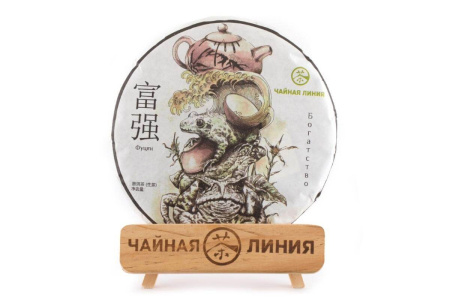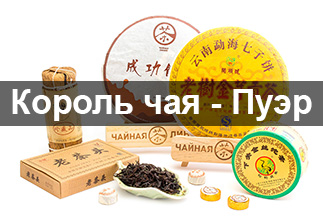Sheng Pu'er "Wealth" 2023: Treasure from the depths of Yunnan
Sheng Puer "Wealth" is a new masterpiece from the Russian tea company "Tea Line", released in 2023. In Chinese, the name of the tea sounds like 富强 (Fùqiáng), which translates as "wealth" and "strong". This name symbolizes not only material well-being, but also the richness of taste, aroma and beneficial properties of this unique tea.
Features of tea
- Name and Philosophy: The name of the tea "Wealth" reflects a deep meaning. This tea not only has a rich taste, but also symbolizes prosperity and well-being.
- Tea Type: Sheng Pu'er is a special type of tea that undergoes minimal processing and continues to ferment after pressing. Because of this, the taste of Sheng Pu'er becomes deeper and more complex over time.
- Pressing form: Bing cha is the traditional pressing form for puerh. The cake is convenient for storage and transportation, and also allows the tea to mature slowly.
- Year of pressing: 2023 is the year of release of this particular cake. Fresh sheng puer has a bright, fruity taste that will develop and acquire new shades over time.
Taste and aroma
Sheng Puer "Wealth" will please tea lovers with its powerful invigorating effect, rich and deep taste. It combines sweet fruity notes, woody shades, and light floral chords. The aroma of tea opens gradually, surprising with new nuances with each subsequent brewing.
Beneficial properties
- Rich in antioxidants: Protects cells from damage and slows down the aging process.
- Improves digestion: Promotes normal functioning of the gastrointestinal tract.
- Tones and invigorates: Increases energy and concentration levels.
- Strengthens the immune system: Increases the body's resistance to various diseases.
How to brew
In order to reveal the full depth of taste of Sheng Puer "Wealth", it is recommended to use water at a temperature of 95-100 degrees Celsius. You can brew tea in a gaiwan or in a teapot. The brewing time depends on personal preference and can vary from 5 to 15 seconds.
Sheng Puer "Wealth" 2023 is not just a drink, it is a symbol of prosperity and well-being. This tea will be a great addition to your tea collection and will allow you to enjoy the richness of taste and aroma of this unique drink.
|
Name in Chinese
|
富强 |
|
Pinyin
|
fùqiáng |
|
Translation
|
Wealth |
|
Country
|
Russia |
- Комментарии
- Вконтакте
Pu-erh is one of the most unique types of tea, which only gets better with age. Many people, when they first encounter this tea, wondered: why is pu-erh more often found in pressed form (cakes, bricks, tochas), and not in loose form? The reasons for this are related to both history and the practical aspects of storing and fermenting tea. Despite modern technologies that allow the production of loose pu-erh, the shape of pressed cakes remains unchanged. And pu-erh is more often found on sale in pressed form, for example, in the form of cakes or bricks, and loose pu-erh is less common. We will talk about the reasons for pressing pu-erh into cakes in this article.
Puer is a unique Chinese tea that is distinguished by its depth of taste, complexity of aromas and versatility of aftertaste. Its taste characteristics are formed under the influence of many factors, from growing conditions to the brewing method. Let's look at the main ones.
Over time, some consumers who are part of the country's "tea elite" discover mainland Chinese tea. And only a few get acquainted with Taiwanese varieties. The path of a tea person is usually long and thorny, but ultimately it leads to the King of Teas - puer. But not everyone is able to go all the way from ordinary teas to puer and appreciate its qualities.
The tea ceremony occupies a special place in the centuries-old Eastern tradition. And although the essence of this phenomenon remains constant, the nature and external manifestations of the tea ceremony in different nations have their own national characteristics. In each Chinese province, the tea ceremony and the tea used in it are varied: for example, residents of the southern provinces prefer green tea, and residents of the northern provinces - red tea, in Fujian province they more often use Oolong tea, and in Yunnan province Puer tea is widely known.






















































































